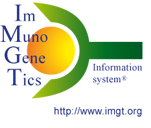Locus
A locus is a set of IG or TR genes that are ordered and are localized in a same chromosomal location, in a given species. An IG or TR locus is characterized by its orientation 5'→3'.
A locus comprises the genes of different groups which participate potentially to the synthesis of a polypeptide of the same 'chain type'. A locus is characterized by its length (usually in Kb or Mb), its cytogenetic chromosomal localization, its orientation and its gene content.
The human genome includes seven main loci for IG and TR (three for IG and four for TR) [1,2]. These loci (also designated as 'major loci') do not include the chromosomal orphon sets.
Locus representations (IMGT Repertoire) are available for the three IG (IGH, IGK, IGL) and the four TR (TRA, TRB, TRD, TRG) human (Homo sapiens) and mouse (Mus musculus) loci.
IMGT/LocusView is available for the human IGL, IGH, TRA/TRD, TRB, TRG, MHC loci and the mouse TRA/TRD locus.
The 'locus' concept is part of the 'LOCALIZATION' concept of IMGT-ONTOLOGY[3]
IG and TR genes have also been identified in other chromosomal locations outside the major loci. These genes, designated as orphons, are not functional and belong to the 'chromosomal orphon sets', which represent another concept of the 'LOCALIZATION' concept of IMGT-ONTOLOGY.
